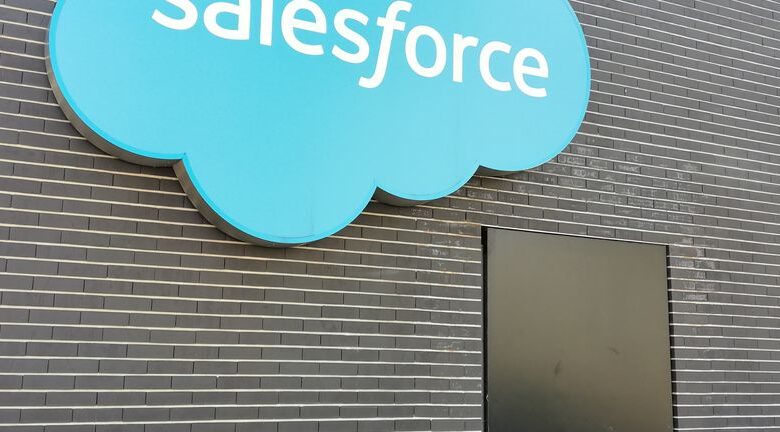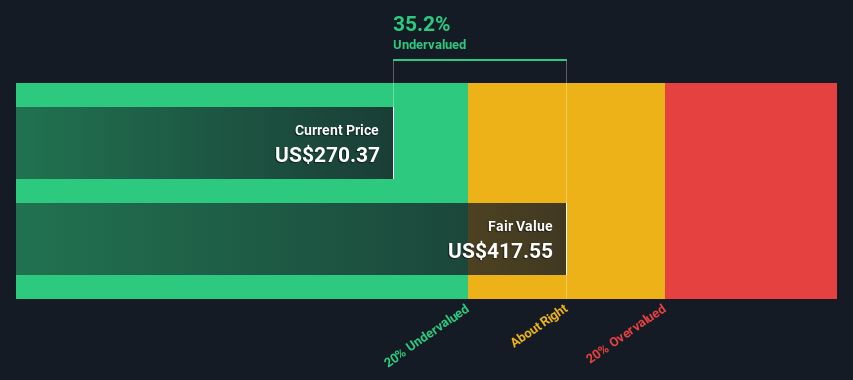Is There An Opportunity With Salesforce, Inc.’s (NYSE:CRM) 35% Undervaluation?

Key Insights
-
Using the 2 Stage Free Cash Flow to Equity, Salesforce fair value estimate is US$418
-
Salesforce is estimated to be 35% undervalued based on current share price of US$270
-
Our fair value estimate is 25% higher than Salesforce’s analyst price target of US$335
Does the April share price for Salesforce, Inc. (NYSE:CRM) reflect what it’s really worth? Today, we will estimate the stock’s intrinsic value by taking the expected future cash flows and discounting them to their present value. One way to achieve this is by employing the Discounted Cash Flow (DCF) model. Models like these may appear beyond the comprehension of a lay person, but they’re fairly easy to follow.
Companies can be valued in a lot of ways, so we would point out that a DCF is not perfect for every situation. Anyone interested in learning a bit more about intrinsic value should have a read of the Simply Wall St analysis model.
View our latest analysis for Salesforce
Crunching The Numbers
We’re using the 2-stage growth model, which simply means we take in account two stages of company’s growth. In the initial period the company may have a higher growth rate and the second stage is usually assumed to have a stable growth rate. To begin with, we have to get estimates of the next ten years of cash flows. Where possible we use analyst estimates, but when these aren’t available we extrapolate the previous free cash flow (FCF) from the last estimate or reported value. We assume companies with shrinking free cash flow will slow their rate of shrinkage, and that companies with growing free cash flow will see their growth rate slow, over this period. We do this to reflect that growth tends to slow more in the early years than it does in later years.
Generally we assume that a dollar today is more valuable than a dollar in the future, so we discount the value of these future cash flows to their estimated value in today’s dollars:
10-year free cash flow (FCF) forecast
|
2024 |
2025 |
2026 |
2027 |
2028 |
2029 |
2030 |
2031 |
2032 |
2033 |
|
|
Levered FCF ($, Millions) |
US$8.52b |
US$11.7b |
US$13.3b |
US$14.7b |
US$17.4b |
US$19.7b |
US$21.5b |
US$22.9b |
US$24.2b |
US$25.3b |
|
Growth Rate Estimate Source |
Analyst x26 |
Analyst x26 |
Analyst x27 |
Analyst x10 |
Analyst x5 |
Analyst x5 |
Est @ 8.82% |
Est @ 6.86% |
Est @ 5.49% |
Est @ 4.53% |
|
Present Value ($, Millions) Discounted @ 6.9% |
US$8.0k |
US$10.3k |
US$10.9k |
US$11.2k |
US$12.4k |
US$13.2k |
US$13.4k |
US$13.4k |
US$13.3k |
US$13.0k |
(“Est” = FCF growth rate estimated by Simply Wall St)
Present Value of 10-year Cash Flow (PVCF) = US$119b
After calculating the present value of future cash flows in the initial 10-year period, we need to calculate the Terminal Value, which accounts for all future cash flows beyond the first stage. For a number of reasons a very conservative growth rate is used that cannot exceed that of a country’s GDP growth. In this case we have used the 5-year average of the 10-year government bond yield (2.3%) to estimate future growth. In the same way as with the 10-year ‘growth’ period, we discount future cash flows to today’s value, using a cost of equity of 6.9%.
Terminal Value (TV)= FCF2033 × (1 + g) ÷ (r – g) = US$25b× (1 + 2.3%) ÷ (6.9%– 2.3%) = US$559b
Present Value of Terminal Value (PVTV)= TV / (1 + r)10= US$559b÷ ( 1 + 6.9%)10= US$286b
The total value is the sum of cash flows for the next ten years plus the discounted terminal value, which results in the Total Equity Value, which in this case is US$405b. In the final step we divide the equity value by the number of shares outstanding. Relative to the current share price of US$270, the company appears quite good value at a 35% discount to where the stock price trades currently. The assumptions in any calculation have a big impact on the valuation, so it is better to view this as a rough estimate, not precise down to the last cent.
The Assumptions
We would point out that the most important inputs to a discounted cash flow are the discount rate and of course the actual cash flows. If you don’t agree with these result, have a go at the calculation yourself and play with the assumptions. The DCF also does not consider the possible cyclicality of an industry, or a company’s future capital requirements, so it does not give a full picture of a company’s potential performance. Given that we are looking at Salesforce as potential shareholders, the cost of equity is used as the discount rate, rather than the cost of capital (or weighted average cost of capital, WACC) which accounts for debt. In this calculation we’ve used 6.9%, which is based on a levered beta of 1.007. Beta is a measure of a stock’s volatility, compared to the market as a whole. We get our beta from the industry average beta of globally comparable companies, with an imposed limit between 0.8 and 2.0, which is a reasonable range for a stable business.
SWOT Analysis for Salesforce
Strength
Weakness
Opportunity
Threat
Looking Ahead:
Whilst important, the DCF calculation shouldn’t be the only metric you look at when researching a company. DCF models are not the be-all and end-all of investment valuation. Rather it should be seen as a guide to “what assumptions need to be true for this stock to be under/overvalued?” For example, changes in the company’s cost of equity or the risk free rate can significantly impact the valuation. Why is the intrinsic value higher than the current share price? For Salesforce, there are three pertinent factors you should further research:
-
Risks: As an example, we’ve found 2 warning signs for Salesforce that you need to consider before investing here.
-
Management:Have insiders been ramping up their shares to take advantage of the market’s sentiment for CRM’s future outlook? Check out our management and board analysis with insights on CEO compensation and governance factors.
-
Other High Quality Alternatives: Do you like a good all-rounder? Explore our interactive list of high quality stocks to get an idea of what else is out there you may be missing!
PS. Simply Wall St updates its DCF calculation for every American stock every day, so if you want to find the intrinsic value of any other stock just search here.
Have feedback on this article? Concerned about the content? Get in touch with us directly. Alternatively, email editorial-team (at) simplywallst.com.
This article by Simply Wall St is general in nature. We provide commentary based on historical data and analyst forecasts only using an unbiased methodology and our articles are not intended to be financial advice. It does not constitute a recommendation to buy or sell any stock, and does not take account of your objectives, or your financial situation. We aim to bring you long-term focused analysis driven by fundamental data. Note that our analysis may not factor in the latest price-sensitive company announcements or qualitative material. Simply Wall St has no position in any stocks mentioned.


![Rick and Michonne Finally Dispose of the CRM in ‘The Ones Who Live’ Finale [Spoilers] Rick and Michonne Finally Dispose of the CRM in ‘The Ones Who Live’ Finale [Spoilers]](https://europeantech.news/wp-content/uploads/2024/04/the-walking-dead-crm-thumb-700xauto-261596-390x220.jpeg)

